|
EQUINE CLICKER TRAINING..... using precision and positive reinforcement to teach horses and people |


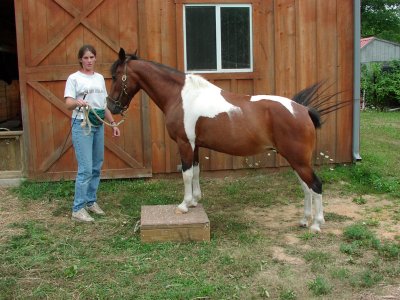
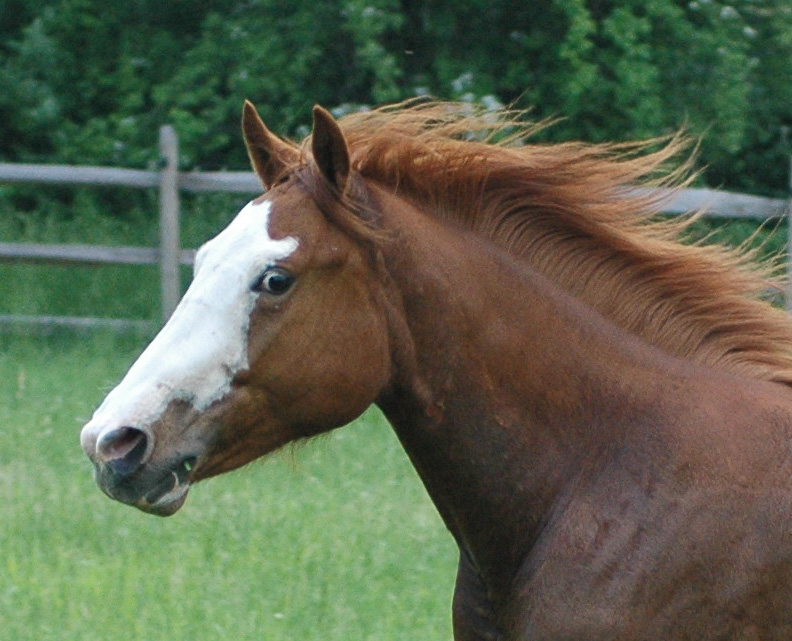
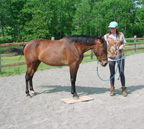

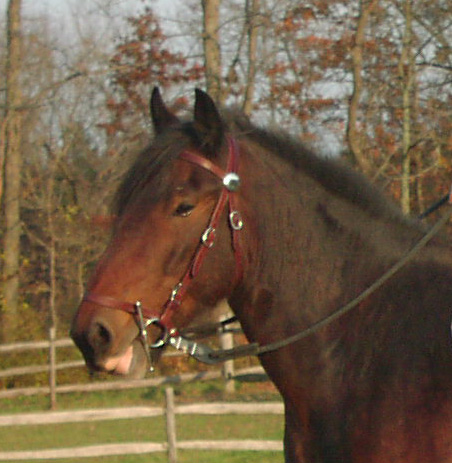
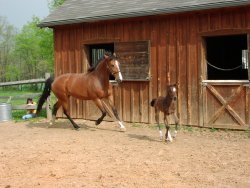 |
|
Single Rein Riding: Practical Applications and Integration With Work on Two Reins
One of the foundations of Alexandra Kurland's clicker work with horses is her single rein riding technique. She uses it in combination with clicker training to teach horses and riders to travel on a release or with a soft contact and to move in balance. The idea is to use one rein at a time and ask for different behaviors and changes in balance by sliding to the point of contact and waiting for a change in the horse. A correct response is reinforced by releasing the rein and clicking and treating. As the horse becomes more advanced, the release itself can become the reinforcement although the clicker (click and treat) is still used for occasional reinforcement and fine tuning.
Horses that have previously been ridden on a restricted contact on two reins seem to love this work on one rein. Riders who have been tense and nervous seem to love this work too. Instead of feeling like the rider has to make the horse comply, there is a sense of togetherness and connection. More information on the mechanics of single rein riding is available in other articles on this web site, on Alex's web site, www.theclickercenter.com, and through her materials.
After spending time on one rein, the rider can progress to riding on two reins by softly picking up the outside rein. The next step is to teach the horse how to balance between the two reins so that instead of feeling trapped, the horse is able to process requests from both sides while staying soft and light. Because the horse has spent time on one rein, the horse has to be reintroduced to the outside rein and learn how to respond correctly to it as an active outside rein. This can be facilitated by using previously learned responses to the inside rein to help the horse stay in balance.
When I first learned single rein riding, I spent a lot of time on one rein with each of my horses and there was quite a learning curve because I had never tried this kind of riding. My background is very traditional and I had always ridden on two reins. But I loved the single rein riding. It was through the single rein riding that I learned to feel what my horse was doing and how I could make adjustments in my horse's balance and position by small changes in my own position.
Making the transition from riding on one rein to riding on two reins was quite challenging for me. One reason was that because of my background, I found it easy to fall back into old patterns of how to ride on two reins. With my older horse, he would comply when I rode him “the old way” but there was a change in his emotional and physical state. I lost a lot of the softness and connection that I had created with the single rein work. With my young horse, she would just get confused.
In addition, my horses were so used to getting all requests from the inside rein, that they were unsure what to do when the outside rein was activated. So, as an interim step, I rode with two reins but I was more active with my inside rein. I think that was ok as a temporary phase and over time, I was able to figure out how to use both the inside and outside reins independently so that I was riding on two reins but using many of the same rein mechanics I learned with single rein riding. Even though this sounds like it makes training a horse this way seem very complicated, it is actually a very logical progression and by the time you get to riding on two reins, both you and your horse have a much greater understanding of how to communicate with each other.
Recently I was asked how much of the time I ride on one rein, or use single rein riding in my training. My initial answer was that I did not use it much any more with my advanced horses, but that I use it with the younger ones if they need it. As I described above, single rein riding is a step in the progression to two reins. I knew that it had changed the way I rode on two reins, but I did not think I was riding on one rein that often. While I knew that the work on two reins had evolved out of the single rein work, I had never really analyzed it and compared it to how I used to ride on two reins. I was aware that the way my horses carried themselves came out of the single rein riding, but I also felt that I had moved to the point where my focus was on teaching them about working on two reins, not on one.
But questions have an odd way of making you pay attention to things that you might otherwise not have noticed, or analyzed. After replying that I did not use it much anymore, I suddenly found myself saying “oh, but I do use it for…” and thinking about it, I realized that as my riding has evolved I am using a blend of riding on one and two reins. When I am on one rein, it is pretty clear that I am using the single rein mechanics. But when I am on two reins, there might be moments when I use the riding to a point of contact and connecting body parts lessons I learned from single rein riding, and other times when I am using the reins in more traditional ways. What I have found is that the process of single rein riding has changed the way I ride whether I am on one rein or two.
The question about how much I ride on a single rein made me think about two other related questions. The first is “if the ultimate goal is to ride on two reins, why spend so much time on one rein?” I have written previously about the advantages of single rein riding and what I learned from it, so I am not going to go into any detail about that here. If you are interested, there are multiple posts on Alex’s the_click_that_teaches yahoo list and also on her web site. In short, single rein riding taught me about feel and timing and how to connect with my horse. It is a wonderful teaching process that breaks down how to use the reins and your body to connect with your horse into small, understandable and achievable pieces.
What I do want to write about is the second question which is “once you can ride on two reins, why would you go back to one?” This is best answered by explaining how my training is a blend of riding on one and two reins. I have been fortunate to have a number of horses to work with during the past few years and most of them were just starting their under saddle training. With them, I did a lot of ground work using Alex's exercises and some of my own to teach them how to be soft, light and responsive to my body language and lead cues. This translated nicely to the ridden work and I have also spent time on the single rein exercises under saddle as part of their basic training.
A lot of the initial riding is done on one rein, but at the risk of confusing you (sorry!) I do want to point out that the transition from one rein to two is not a linear progression. It is more of a back and forth between one rein and two as I respond to what the horse needs. So, while I start on one rein, I do like to introduce the idea of the second rein early enough that the horse has some awareness of it. I will spend time teaching the horses that if I pick up both reins and ask for forward, I want them to march straight ahead and that every single rein request does not mean I want them to bend and give. Doing this counterbalances some of the wiggliness that can come from single rein riding.
I am making a distinction here between riding on two reins to teach a baby about listening with both sides of his body and the kind of riding on two reins that evolves out of the single rein process. Both involve riding on two reins, but they are not quite the same so my early work on two reins has a slightly different goal than my later work on two reins. The early riding on two reins is just meant to introduce the idea that I can ride on two reins and I am only mentioning it here because I don't want to give the impression that I never ride on two reins until the horse understands how to be soft and light on one rein. My real focus is on getting the horse connected through the inside rein so that I can pick up and activate the outside rein as an active outside rein.
I hope this is not making things too confusing! My point really is that in any ride, there are times when I am on a single rein, times when I am on two reins but not doing "single rein work" and times when I am picking up the outside rein as part of the progression of single rein riding. The horses know what I am doing by how I pick up the reins. Over time, I spend more and more time on two reins, but there are still times when I go back to the single rein exercises, and this is what I want to share. The single rein exercises form the foundation of my connection with my horse and create lightness and softness. Any time I lose those, I have the option of going back to one rein and reconnecting.
Some typical examples of times I use single rein riding on one rein are:
Anxious, high headed horses: Single rein riding can calm these horses down. Just asking for baby gives and asking the horse to stretch down can decompress him, encourage him to relax and defuse his energy without making him feel trapped. By only using one rein, you can ask the horse to give each side of his jaw. If I get on a horse that feels nervous, quick or anxious, I just start asking for gives.
Even if the horse has never been asked for a give before, the process of sliding down and waiting gives him time to think, respond and then relax. If I have taught head lowering, I can use that to calm a horse too, but if I am on a horse that does not know head lowering, asking for baby gives will lead to lowering of the horse’s head without the need to teach a formal head down cue.
Warm-up or Stiff horses: I can use single rein riding to progressively loosen the horse. In the beginning of almost every ride, I do a little single rein work to see if my horse is stiff or braced anywhere. I usually check to see if I can ask for all the different body parts. If one is sticky, then I spend some time on a single rein exercise to soften it. Or sometimes, I just start with baby gives of the jaw. As I continue to ask for gives the horse will supple himself from front to back. He might just offer a bit of softness in the jaw first, but then he will offer some neck bend or softening at the poll, then moving of the shoulders, back and hips.
Lateral work: For horses that have no understanding of sideways movement, I can use single rein riding to set them up for sideways movement. It is easier for horses to learn to move sideways when they are bent away from the direction of movement. I can use baby gives to get the jaw, shoulders and hips loosened up and create bend. Then I can ask the horse to move sideways and they will already be in position to do it. I use Alex’s exercises to develop some lateral movement and then use that to train a more traditional leg yield and turn on the forehand.
I have included lateral work in this list because I have found that if I am riding or schooling a horse that does not know single rein riding but is having trouble with lateral work, I can use a modified single rein approach to help the horse soften and find the correct alignment to learn about moving sideways. Usually lateral work evolves out of Alex’s work and I do not teach it as a separate piece. But if I am schooling a horse for someone else, I have found that the fact that I know and can use single rein riding helps me set the horse up to do the movements correctly.
The rein pickup: Single rein riding teaches a very methodical rein pickup where I slide down the inside rein, connect with the horse’s inside jaw and then pick up the outside rein. If at any point in this process, the horse becomes stiff, I can go back and start over, or I can use that as a diagnostic for where I might need to focus my attention. I have a variety of ways that I pick up the reins but if I find a horse getting a bit braced or crooked or resistant, I always go back to the very methodical single rein pickup to see where the problem is.
Reconnecting with a Body Part: Single rein riding makes horses very soft and loose. Riding on two reins can make them straighter but it can also make them tense and stiff. If I am riding on two reins and I feel like my horse is getting heavy, stiff, or losing its suppleness, I will go back to single rein riding and start checking to see where the horse might be blocked or bracing. I find there is always a balancing act between having a horse connected and well aligned and having a horse get stiff, especially if you are working on straight lines.
Trail riding: Most of my trail riding is walking on a long rein. When I ride on the buckle and suddenly need to pick up the reins because my horse spooks, sliding down one rein is the fastest way to get a horse under control. I can bring the hip around and stop the horse without engaging in a pulling match. If my horse has already learned to give his jaw and hip with single rein riding, asking him to stop in this manner will not be distressing to him and when he has stopped I can release the rein and the horse will understand I want a stop.
This is something that works because I have practiced it a lot. In order for the slide down the rein to be fast and automatic, you have to practice it in a quiet setting so that you slide down and ask for a stop before you even have time to think. If you do it enough, it will become automatic and if your horse has practiced with you, that is even better.
The categories above suggest that single rein riding can be pulled out and used as needed and I certainly do it that way. But I think one reason I can do that is because I have spent time going through the whole progression, so I know which pieces I need to use when and which ones will not work without some other basic work done first. I strongly recommend that anyone new to single rein riding goes through Alex’s whole progression if they really want to understand how single rein riding works. So, I am not suggesting that this is the idea way to learn it. What I am trying to show is that time spent learning single rein riding is well spent because even after you are riding on two reins the majority of the time, the single rein skills and foundation lessons combined together form a strong foundation that can be used to overcome various training challenges.
A Little Story
With that in mind, I did want to share a little story that shows how single rein riding was helpful in a situation I encountered in my every day riding. This story is about an experience I had recently with Red, the youngest of my current riding horses. Red is a 5 year old QH gelding who I have been riding for about a year. I spent quite a lot of time in the ring with him, getting him started and comfortable at walk, trot and canter. In the last few months, we have been venturing out on the trails.
Starting young horses out on the trails is difficult for me as I don’t have a regular riding partner so I have to take green horses out alone. I usually start by riding them around my yard and then around the back horse field and slowly expanding my route to include some neighboring fields. I spend a long time at the walk and I tend to click for basic things like stop, go, and touching or going by scary objects. My end goal is to have a trail horse that is comfortable walking along on the buckle and enjoys going out. I tend to use trail riding as a change of pace from the ring work or a way to get out on a nice day. So I am pretty casual. Even on my more experienced trail horses, I like to just amble along.
Red has been doing pretty well. He had a past history or spooking and bolting so I have taken it slow and he now goes around the field next door without much trouble. The field has both corn and soybeans planted in it and this time of year the corn is tall, so there is a narrow corridor around the edges. Red gets a bit nervous some days and I don’t blame him. Things tend to jump out of the corn when we are coming along and so I will let him stop and look around if he needs to.
Last week I was riding him out and we came around the back of the field and could hear a loud noise coming from a barn under construction across the street. It sounded like heavy machinery but I could not see it because of the corn. In general, I do not like to turn horses around on the trail when they encounter something scary. I don’t want them to get the idea that turning around and going back is a good idea. I would rather give the horse time to approach the object and see that it is ok and then continue on forward. But on this particular morning I had limited riding time and I was not sure we would be able to handle a scary situation in a timely manner, so we turned around and went home. I did ask him to stop multiple times on the way home and I reinforced it a lot so that we proceeded home at a calm pace.
I forgot about this incident until the next ride when I was headed down the same path and Red stopped and refused to go. He was at about the same place where we had turned last time and he was looking down the path with some anxiety. This time there was no noise so I just let him stand and look. Then he started to back up and tried to turn. To make a long story short, I spent about 10 minutes there with him. He worked through a number of behaviors including backing, turning, mini-rears and just standing still. At one point, he turned sideway and then backed into the corn, freaking himself out with the crunching of the corn stalks and hopping up and down a bit. While I considered getting off and leading him, I was not sure that was the safest option. I have no problem with getting off a horse to lead them by a difficult object, but in this case, I thought it was better to stay on. Eventually he just stopped and waited and I was able to click him for standing still and then ask him to go forward and click for any baby steps in the right direction. Once he got going, he marched on home at a good pace, but without jigging or trying to bolt or any other signs of extreme tension.
When I got back to the barn, I sat down and thought about the whole thing. It could have turned out badly but I think there were two important things that helped me handle the situation. One was clicker training and the other was single rein riding. Being able to use the clicker to mark forward movement was helpful in this situation. I don’t think it was so much that the click and treat was motivating to him, but I think he seemed to find something reassuring about the fact that I was clicking and treating and it was telling him what I wanted. It was a familiar element in an uncertain situation. For me, clicker training made a huge difference because I knew I did not have to “make” him go. I knew that if I could just wait him out, I would get something I could mark and then we could build forward from there.
It takes a huge amount of pressure off a rider if they know that they have time and a way to get the behavior they want, instead of feeling like they have to correct a horse for disobedience or make the horse go. I remember sitting on him thinking “this is ok, just wait him out.” And because I did not get caught up in his emotional meltdown, I did not add to his anxiety. In addition to clicking, I think another thing that really helped was the fact that he was comfortable standing on a loose rein and I was able to let him have it because I knew that with our single rein riding work, I did not have to hold him tightly to have control.
When I trail ride, I do a lot of walking on the buckle and if I want to ask the horse for something, I slide down one rein and ask. Once the horse has answered correctly, I release and go back to a long rein. My horses are used to having a long rein and they have learned that a long rein means walk calmly forward. I have met horses that interpret a loosening of the reins to mean "go" or are not sure what to do if given a long rein because they have always been held so tightly. The fact that Red was calm and able to stand even though the rein was loose was important. In addition, I have also spent a lot of time gently teaching him to take his hips around. So if I am in a situation where he is upset, instead of shortening both reins and getting tight and tense myself, I will just keep taking his hip around and releasing until he can stand or walk calmly forward on a long rein.
It is amazing what a difference it makes to have a horse that can walk calmly forward or stand on a loose rein even when it is upset. In the situation with Red, I was able to use single rein riding to ask him to stop and also to change direction when he wanted to turn away. This meant I did not have to go to both reins which might have made him feel blocked or more anxious. Because I stayed relaxed and was able to keep releasing, he never got to the exploding point.
This is not a situation I would like to repeat, but I think it does illustrate how single rein riding is useful on the trail and how a horse that understands about requests from one rein can be ridden through a difficult situation. In this case, it was important that both Red and I knew single rein riding before we went out, but I think my understanding of it would help me in other situations, even if the horse was not familiar with it.
And as a nice ending to the story, I took Red out on the same path a few days after the incident I described. He had some ambivalence about entering the narrow path by the corn, but I let him stop and then clicked for forward motion. From there, he marched right along. He was a bit nervous but also clearly understood that going forward was the right answer. I would like to think that his relative calmness and willingness to go forward were because we were able to calmly work through his issues the last time out. If I had felt compelled to “make him go,” it might have made him more anxious about the situation and carried over to the next time out. I believe that by using a combination of single rein riding and clicking, I was able to help him overcome his fear and become more confident, which will make him a better and more enjoyable trail horse.
Katie Bartlett 2006, -
please do not copy or distribute without my permission
Home |
Articles |
Clicker Basics |
Community |
FAQ |
Getting Started |
Horse Stories |
Links |
Photos |
Resources
|
||||